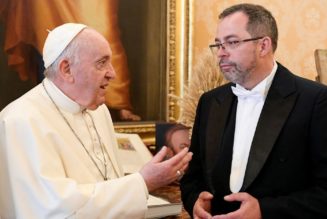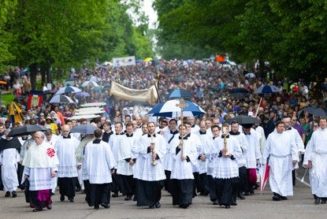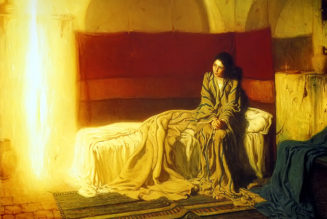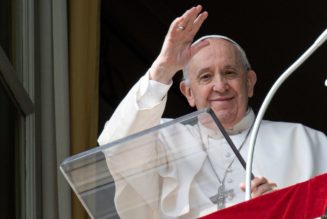
COMMENTARY: The greatest value of ‘The Gardens of God’ is as an occasion for building communion in the Church.
At the prayer vigil to launch the Synod on Synodality, St. Peter’s Square was decorated to look like a garden. That prompted me to return to some recent summer reading, The Gardens of God by Cardinal Arthur Roche, prefect of the Dicastery for Divine Worship. I recommend it as a welcome tonic against the toxins of polarization in the Church today.
At the synod on Wednesday, Cardinal Roche took a routine role in the opening prayers. He read the passage from the Liturgy of the Hours for the feast of Pope St. John XXIII, which is an excerpt from the Holy Father’s opening address at Vatican II, Gaudet Mater Ecclesia (Mother Church Rejoices). The address was given on Oct. 11, 1962, which is why that date was chosen for St. John XXIII’s feast day.
The combination of Cardinal Roche and Vatican II provoked murmuring in the parts of the Catholic internet where the prefect is regarded with special obloquy for his role in restricting the “extraordinary form” or “traditional Latin Mass” after the 2021 legislation of Pope Francis, Traditionis Custodes (Guardians of the Tradition).
Indeed, extra opprobrium is reserved for Cardinal Roche, as he was an enthusiastic supporter of Pope Benedict XVI’s Summorum Pontificum, which Pope Francis reversed. Now, he curtails what he once celebrated.
Supporters of Cardinal Roche would point to that as docility to the Holy Father he serves as a Curial official; critics characterize it as sycophancy. Such is the case with various figures in the Church today; their very presence provokes a polarized, even partisan, response. Communion is damaged.
Hence the welcome decision by Bishop Robert Barron’s Word on Fire to publish The Gardens of God, a collection of retreat talks. It came out in the spring and could serve as spiritual reading for more traditional Catholics during the Synod on Synodality for a synodal Church. I found it a consoling read.
The Gardens of God, released in May, is a collection of retreat conferences preached to bishops and priests. Organized around the theme of gardens, it notes that creation begins with God “planting a garden” (Genesis 2:8). Cardinal Roche organizes his meditations around the garden of sin (Eden), the garden of suffering (Gethsemane), the garden of victory (the Risen Christ mistaken for the “gardener”) and the garden of paradise (heaven).
A particularly creative chapter on the Blessed Virgin Mary is entitled the “Enclosed Garden,” one of her “lesser-known titles.” It originates in the Song of Songs:
“A garden locked is my sister, my bride, a spring locked, a fountain sealed” (4:12).
The book is profoundly scriptural, but also draws from venerable sources such as Dante’s Paradiso and St. Bernard of Clairvaux, as well as more recent authors such as Paul Claudel and St. John Henry Newman — the great “mission of my life” prayer is quoted in full. There are the winsome references that enliven a retreat conference — to Harry Houdini, for example.
Pope Francis is cited frequently; one particular quotation is quite timely, on the essential need for Eucharistic adoration: “Adoration involves making an exodus from the greatest bondage: slavery to oneself.” In the months since the book was published, the Holy Father returned several times to that theme.
The greatest value of the book, though, is as an occasion for building communion in the Church. If various parties in the Church act as partisans, always looking for the foibles and failings of the “other” parties, then the partisan spirit will give rise to polarization and factionalism. In the current political and cultural context, which spills over into ecclesial life, we are guilty of it to some extent. Faithful Catholics ought to lament this, but might find themselves frustrated by a lack of concrete responses.
For traditionally minded, more conservative Catholics who have recently become suspicious of senior prelates, including Cardinal Roche, reading The Gardens of God is such a concrete action. A shared faith breathes through the text, biblically, traditionally and liturgically.
Yes, liturgically — fittingly enough for the prefect of liturgy! There are quarters where liturgical direction from Cardinal Roche would be instinctively resisted. But consider these lines, wherein Cardinal Roche offers his readers a rather beautiful exposition of the Roman Canon, wherein the Latin is richer than the English:
“In the Roman Canon, we learn that the bishop is one who, ‘holding to the truth, hands on the catholic and apostolic faith.’ This English translation, however, doesn’t capture the entire meaning of the Latin text. Orthodoxis atque catholicae et apostolicae is a description of bishops, who are defined as fidei cultoribus, the ones who cultivate and hand on the Catholic and Apostolic faith.”
Fidei cultoribus doesn’t quite make it into our English translation, except as those who “hand on” the faith. The original Latin, Cardinal Roche proposes, presents the image of a gardener. God is the aboriginal gardener — “for there was no man to work the ground” (Genesis 2:5) — and the Risen Christ will return as the “gardener” outside the empty tomb. His meditation on the gardener, to complement the image of the shepherd (or the fisherman), is worth quoting in full:
“The word cultor comes from the Latin verb colo, colere, which means ‘to cultivate.’ A cultor fidei is someone who cultivates faith like a gardener cultivates the land. He is someone who plants a tree in the soil that reaches to the heavens! The word ‘column,’ interestingly, has the same derivation. Classical architecture makes it easy for us to recognize trees in the magnificent columns of Greece and Rome where we see before our eyes stone trunks of trees whose capitals bear the semblance of branches and foliage.
“The cultor is someone who plants and harvests, who works and cares for the crops, the vines, who keeps bees and tends the beasts. These are all the original Latin usages. So, from within the context of the Eucharistic Prayer, we can say that bishops and priests are gardeners and farmers, as well as shepherds! They have to work at ground level, in the dust, among the weeds in God’s field.
“The cultor belongs to the land, which is one of the reasons why bishops have a specific territory in their titles. It is here, in his territory, that he plants and cultivates and brings in the harvest.”
For those who have a particular devotion to the Roman Canon — especially those who prefer it in Latin — that provides a rich, biblical vision of a preliminary line often passed over quickly. In more than 20 years of praying fidei cultoribus, I had never thought of the Divine Gardener calling bishops and priests into his work as fellow gardeners, cultivators.
Cardinal Roche provides another liturgical comment on the garden, this time for all the baptized.
“The cultivation of this garden, through Baptism, is made very clear in the Third Eucharistic Prayer where, praying for the dead, we say, ‘Who was united [complantatus fuit] with your Son in a death like his, may also be one with him in his Resurrection.’
“But the phrase complantatus fuit (keeping Romans 6:5 in mind), actually means that in Baptism, which is derived from the verb ‘to plunge,’ we are planted in the same furrow of the earth, as it were, in which Christ was planted in death in order to rise with him to life. And finally, there is the Garden of Paradise, the garden of eternal life, the garden where the new tree of life, the cross, bears the fruit which is Christ’s Body. This garden is where the complete gathering of the Church takes place even now as well as at the end of time.”
There are other illuminating biblical-liturgical passages in Cardinal Roche’s conferences, but these two show that, setting aside current controversies, there is a shared appreciation for the riches of the Church’s prayer in Latin.
Internet denizens who bristle at Cardinal Roche might find themselves sharing spiritual communion with him if they sit down with his book, which sets out from “the garden of earthly paradise through to the garden of Joseph of Arimathea where Jesus appeared to Mary Magdalene as a gardener, an hortulanus, and finally to the garden of the heavenly paradise.”








